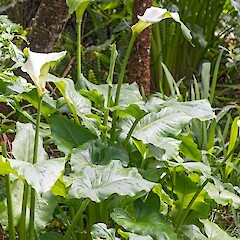Zantedeschia aethiopica ‘Green Goddess’
Common name
green goddess
Family
Araceae
Flora category
Vascular – Exotic
Structural class
Herbs - Monocots
Conservation status
Not applicable
Brief description
Evergreen clump forming plant with large arrowhead shaped leaves ( up to 45 cm long and 25 cm wide) and green flushed with white funnel shaped flowers (up to 25 cm long) with a bright yellow narrow sausage shaped centre (actually the flowers, the other part is a modified leaf).
Distribution
Scattered throughout northern North Island, less common in southern North Island and northern South Island.
Habitat
Swampy areas, often under willows and other damp shaded areas.
Detailed description
Robust, evergreen, erect, clump-forming, to 1.5 m high, in close-set tufts from a tuberous rootstock with white fleshy roots; new tubers arising from shoots on the rootstock. Leaves large, leathery; laminae sagittate or ovate-cordate, 15-45 × 10-25 cm, dark green, the very fine veins somewhat lighter green, shining, entire, tip apiculate, margins undulate; petiole 40-100 cm long, lighter green, spongy, white on inside, purplish on outside. Scape ± = leaves, green, stout. Spathe green variously flushed with white, to 25 cm long, funnel-shaped, narrowed towards tip with a recurved apiculus to 2 cm long. Spadix ± ½ spathe, bright yellow; basal female zone, with staminodia interspersed, c. ¼-½ length of spadix, contiguous with upper male zone; sterile terminal appendage 0. Berries green or yellow, to ± 1 cm diam.
Similar taxa
Unlike most other wetland plants, but two other large plants in the arum family are superficially similar. Taro (Colocasia esculenta) and elephant ear (Alocasia brisbanensis) also have large leaves but arum can be distinguished by the veins of the leaf being the same colour as the rest of the leaf and the spathe being green and white, rather than uniform green or yellow.
Flowering
October to December
Flower colours
Green, Yellow
Fruiting
Southern Africa
Life cycle
Seeds prolifically (Walter Stahel pers com). Seeds dispersed by water movement, birds and other animals. Local clonal spread by rhizomes, with longer distance spread by water movement, deliberate planting and garden discards.
Year naturalised
2002
Origin
S. Africa, cultivation
Reason for introduction
Ornamental plant
Control techniques
Can be controlled manually, mechanically or herbicidally depending on situation.
Tolerances
Appear to be wider than for Zantedeschia aethiopica. The plant is tolerant of deep shade as well as full sun light. (Walter Stahel pers com)
Attribution
Factsheet prepared by Paul Champion and Deborah Hofstra (NIWA). Features description from Healy and Edgar (1980).
References and further reading
Healy, A.J.; Edgar, E. (1980). Flora of New Zealand, Volume III. Adventive Cyperaceous, Petalous and Spathaceous Monocotyledons. Government Printer, Wellington. 220pp.
Weeds of Australia (http://keyserver.lucidcentral.org/weeds/data/03030800-0b07-490a-8d04-0605030c0f01/media/Html/Zantedeschia_aethiopica.htm)
Johnson PN, Brooke PA (1989). Wetland plants in New Zealand. DSIR Field Guide, DSIR Publishing, Wellington. 319pp.
Popay et al (2010). An illustrated guide to common weeds of New Zealand, third edition. NZ Plant Protection Society Inc, 416pp.





